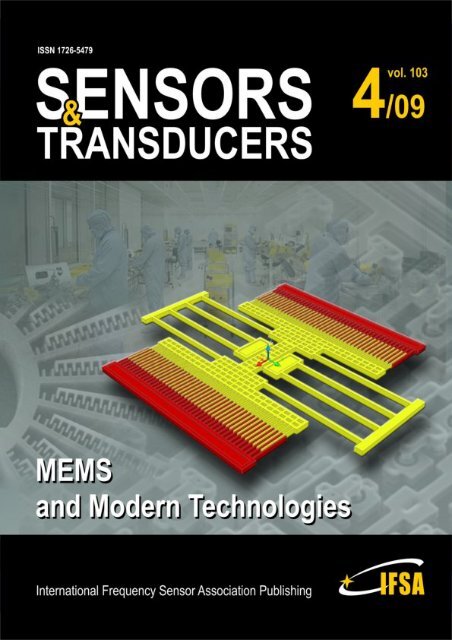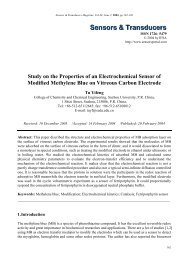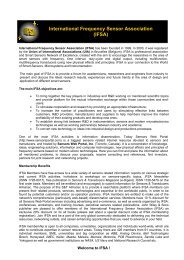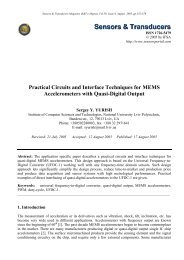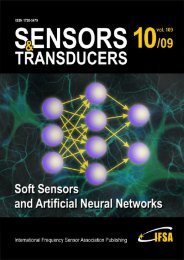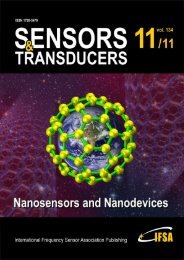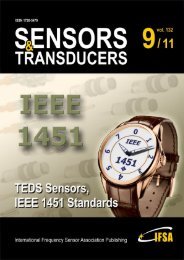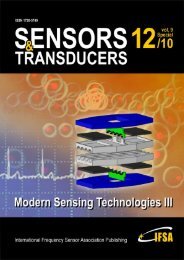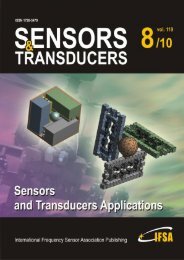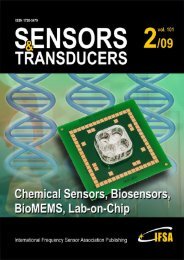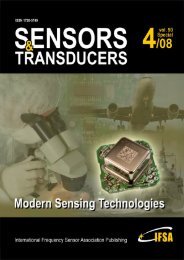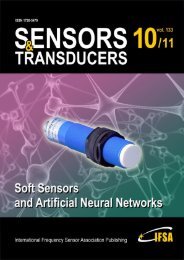Effect of Polyimide Variation and its Curing Temperature on CMOS ...
Effect of Polyimide Variation and its Curing Temperature on CMOS ...
Effect of Polyimide Variation and its Curing Temperature on CMOS ...
Create successful ePaper yourself
Turn your PDF publications into a flip-book with our unique Google optimized e-Paper software.
Sensors & TransducersVolume 103, Issue 4April 2009www.sensorsportal.com ISSN 1726-5479Editor-in-Chief: pr<str<strong>on</strong>g>of</str<strong>on</strong>g>essor Sergey Y. Yurish, ph<strong>on</strong>e: +34 696067716, fax: +34 93 4011989, e-mail: editor@sensorsportal.comEditors for Western EuropeMeijer, Gerard C.M., Delft University <str<strong>on</strong>g>of</str<strong>on</strong>g> Technology, The Netherl<str<strong>on</strong>g>and</str<strong>on</strong>g>sFerrari, Vittorio, Universitá di Brescia, ItalyEditor South AmericaCosta-Felix, Rodrigo, Inmetro, BrazilEditor for Eastern EuropeSachenko, Anatoly, Ternopil State Ec<strong>on</strong>omic University, UkraineAbdul Rahim, Ruzairi, Universiti Teknologi, MalaysiaAhmad, Mohd Noor, Nothern University <str<strong>on</strong>g>of</str<strong>on</strong>g> Engineering, MalaysiaAnnamalai, Karthigeyan, Nati<strong>on</strong>al Institute <str<strong>on</strong>g>of</str<strong>on</strong>g> Advanced Industrial Science<str<strong>on</strong>g>and</str<strong>on</strong>g> Technology, JapanArcega, Francisco, University <str<strong>on</strong>g>of</str<strong>on</strong>g> Zaragoza, SpainArguel, Philippe, CNRS, FranceAhn, Jae-Pyoung, Korea Institute <str<strong>on</strong>g>of</str<strong>on</strong>g> Science <str<strong>on</strong>g>and</str<strong>on</strong>g> Technology, KoreaArndt, Michael, Robert Bosch GmbH, GermanyAscoli, Giorgio, George Mas<strong>on</strong> University, USAAtalay, Selcuk, In<strong>on</strong>u University, TurkeyAtghiaee, Ahmad, University <str<strong>on</strong>g>of</str<strong>on</strong>g> Tehran, IranAugutis, Vygantas, Kaunas University <str<strong>on</strong>g>of</str<strong>on</strong>g> Technology, LithuaniaAvachit, Patil Lalch<str<strong>on</strong>g>and</str<strong>on</strong>g>, North Maharashtra University, IndiaAyesh, Aladdin, De M<strong>on</strong>tfort University, UKBahreyni, Behraad, University <str<strong>on</strong>g>of</str<strong>on</strong>g> Manitoba, CanadaBaoxian, Ye, Zhengzhou University, ChinaBarford, Lee, Agilent Laboratories, USABarlingay, Ravindra, RF Arrays Systems, IndiaBasu, Sukumar, Jadavpur University, IndiaBeck, Stephen, University <str<strong>on</strong>g>of</str<strong>on</strong>g> Sheffield, UKBen Bouzid, Sihem, Institut Nati<strong>on</strong>al de Recherche Scientifique, TunisiaBenachaiba, Chellali, Universitaire de Bechar, AlgeriaBinnie, T. David, Napier University, UKBisch<str<strong>on</strong>g>of</str<strong>on</strong>g>f, Gerlinde, Inst. Analytical Chemistry, GermanyBodas, Dhananjay, IMTEK, GermanyBorges Carval, Nuno, Universidade de Aveiro, PortugalBousbia-Salah, Mounir, University <str<strong>on</strong>g>of</str<strong>on</strong>g> Annaba, AlgeriaBouvet, Marcel, CNRS – UPMC, FranceBrudzewski, Kazimierz, Warsaw University <str<strong>on</strong>g>of</str<strong>on</strong>g> Technology, Pol<str<strong>on</strong>g>and</str<strong>on</strong>g>Cai, Chenxin, Nanjing Normal University, ChinaCai, Qingyun, Hunan University, ChinaCampanella, Luigi, University La Sapienza, ItalyCarvalho, Vitor, Minho University, PortugalCecelja, Franjo, Brunel University, L<strong>on</strong>d<strong>on</strong>, UKCerda Belm<strong>on</strong>te, Judith, Imperial College L<strong>on</strong>d<strong>on</strong>, UKChakrabarty, Ch<str<strong>on</strong>g>and</str<strong>on</strong>g>an Kumar, Universiti Tenaga Nasi<strong>on</strong>al, MalaysiaChakravorty, Dipankar, Associati<strong>on</strong> for the Cultivati<strong>on</strong> <str<strong>on</strong>g>of</str<strong>on</strong>g> Science, IndiaChanghai, Ru, Harbin Engineering University, ChinaChaudhari, Gajanan, Shri Shivaji Science College, IndiaChen, Jiming, Zhejiang University, ChinaChen, R<strong>on</strong>gshun, Nati<strong>on</strong>al Tsing Hua University, TaiwanCheng, Kuo-Sheng, Nati<strong>on</strong>al Cheng Kung University, TaiwanChiang, Jeffrey (Cheng-Ta), Industrial Technol. Research Institute, TaiwanChiriac, Horia, Nati<strong>on</strong>al Institute <str<strong>on</strong>g>of</str<strong>on</strong>g> Research <str<strong>on</strong>g>and</str<strong>on</strong>g> Development, RomaniaChowdhuri, Arijit, University <str<strong>on</strong>g>of</str<strong>on</strong>g> Delhi, IndiaChung, Wen-Yaw, Chung Yuan Christian University, TaiwanCorres, Jesus, Universidad Publica de Navarra, SpainCortes, Camilo A., Universidad Naci<strong>on</strong>al de Colombia, ColombiaCourtois, Christian, Universite de Valenciennes, FranceCusano, Andrea, University <str<strong>on</strong>g>of</str<strong>on</strong>g> Sannio, ItalyD'Amico, Arnaldo, Università di Tor Vergata, ItalyDe Stefano, Luca, Institute for Microelectr<strong>on</strong>ics <str<strong>on</strong>g>and</str<strong>on</strong>g> Microsystem, ItalyDeshmukh, Kiran, Shri Shivaji Mahavidyalaya, Barshi, IndiaDickert, Franz L., Vienna University, AustriaDieguez, Angel, University <str<strong>on</strong>g>of</str<strong>on</strong>g> Barcel<strong>on</strong>a, SpainDimitropoulos, Panos, University <str<strong>on</strong>g>of</str<strong>on</strong>g> Thessaly, GreeceDing, Jianning, Jiangsu Polytechnic University, ChinaDjordjevich, Alex<str<strong>on</strong>g>and</str<strong>on</strong>g>ar, City University <str<strong>on</strong>g>of</str<strong>on</strong>g> H<strong>on</strong>g K<strong>on</strong>g, H<strong>on</strong>g K<strong>on</strong>gEditorial Advisory BoardEditors for North AmericaDatskos, Panos G., Oak Ridge Nati<strong>on</strong>al Laboratory, USAFabien, J. Josse, Marquette University, USAKatz, Evgeny, Clarks<strong>on</strong> University, USAEditor for AsiaOhyama, Shinji, Tokyo Institute <str<strong>on</strong>g>of</str<strong>on</strong>g> Technology, JapanEditor for Asia-PacificMukhopadhyay, Subhas, Massey University, New Zeal<str<strong>on</strong>g>and</str<strong>on</strong>g>D<strong>on</strong>ato, Nicola, University <str<strong>on</strong>g>of</str<strong>on</strong>g> Messina, ItalyD<strong>on</strong>ato, Patricio, Universidad de Mar del Plata, ArgentinaD<strong>on</strong>g, Feng, Tianjin University, ChinaDrljaca, Predrag, Instersema Sensoric SA, Switzerl<str<strong>on</strong>g>and</str<strong>on</strong>g>Dubey, Venketesh, Bournemouth University, UKEnderle, Stefan, University <str<strong>on</strong>g>of</str<strong>on</strong>g> Ulm <str<strong>on</strong>g>and</str<strong>on</strong>g> KTB Mechatr<strong>on</strong>ics GmbH,GermanyErdem, Gursan K. Arzum, Ege University, TurkeyErkmen, Aydan M., Middle East Technical University, TurkeyEstelle, Patrice, Insa Rennes, FranceEstrada, Horacio, University <str<strong>on</strong>g>of</str<strong>on</strong>g> North Carolina, USAFaiz, Adil, INSA Ly<strong>on</strong>, FranceFericean, Sorin, Balluff GmbH, GermanyFern<str<strong>on</strong>g>and</str<strong>on</strong>g>es, Joana M., University <str<strong>on</strong>g>of</str<strong>on</strong>g> Porto, PortugalFrancioso, Luca, CNR-IMM Institute for Microelectr<strong>on</strong>ics <str<strong>on</strong>g>and</str<strong>on</strong>g>Microsystems, ItalyFrancis, Laurent, University Catholique de Louvain, BelgiumFu, Weiling, South-Western Hospital, Ch<strong>on</strong>gqing, ChinaGaura, Elena, Coventry University, UKGeng, Yanfeng, China University <str<strong>on</strong>g>of</str<strong>on</strong>g> Petroleum, ChinaGole, James, Georgia Institute <str<strong>on</strong>g>of</str<strong>on</strong>g> Technology, USAG<strong>on</strong>g, Hao, Nati<strong>on</strong>al University <str<strong>on</strong>g>of</str<strong>on</strong>g> Singapore, SingaporeG<strong>on</strong>zalez de la Rosa, Juan Jose, University <str<strong>on</strong>g>of</str<strong>on</strong>g> Cadiz, SpainGranel, Annette, Goteborg University, SwedenGraff, Mas<strong>on</strong>, The University <str<strong>on</strong>g>of</str<strong>on</strong>g> Texas at Arlingt<strong>on</strong>, USAGuan, Shan, Eastman Kodak, USAGuillet, Bruno, University <str<strong>on</strong>g>of</str<strong>on</strong>g> Caen, FranceGuo, Zhen, New Jersey Institute <str<strong>on</strong>g>of</str<strong>on</strong>g> Technology, USAGupta, Narendra Kumar, Napier University, UKHadjiloucas, Sillas, The University <str<strong>on</strong>g>of</str<strong>on</strong>g> Reading, UKHashsham, Syed, Michigan State University, USAHasni, Abdelhafid, Bechar University, AlgeriaHern<str<strong>on</strong>g>and</str<strong>on</strong>g>ez, Alvaro, University <str<strong>on</strong>g>of</str<strong>on</strong>g> Alcala, SpainHern<str<strong>on</strong>g>and</str<strong>on</strong>g>ez, Wilmar, Universidad Politecnica de Madrid, SpainHomentcovschi, Dorel, SUNY Binghamt<strong>on</strong>, USAHorstman, Tom, U.S. Automati<strong>on</strong> Group, LLC, USAHsiai, Tzung (John), University <str<strong>on</strong>g>of</str<strong>on</strong>g> Southern California, USAHuang, Jeng-Sheng, Chung Yuan Christian University, TaiwanHuang, Star, Nati<strong>on</strong>al Tsing Hua University, TaiwanHuang, Wei, PSG Design Center, USAHui, David, University <str<strong>on</strong>g>of</str<strong>on</strong>g> New Orleans, USAJaffrezic-Renault, Nicole, Ecole Centrale de Ly<strong>on</strong>, FranceJaime Calvo-Galleg, Jaime, Universidad de Salamanca, SpainJames, Daniel, Griffith University, AustraliaJanting, Jakob, DELTA Danish Electr<strong>on</strong>ics, DenmarkJiang, Liudi, University <str<strong>on</strong>g>of</str<strong>on</strong>g> Southampt<strong>on</strong>, UKJiang, Wei, University <str<strong>on</strong>g>of</str<strong>on</strong>g> Virginia, USAJiao, Zheng, Shanghai University, ChinaJohn, Joachim, IMEC, BelgiumKalach, Andrew, Vor<strong>on</strong>ezh Institute <str<strong>on</strong>g>of</str<strong>on</strong>g> Ministry <str<strong>on</strong>g>of</str<strong>on</strong>g> Interior, RussiaKang, Mo<strong>on</strong>ho, Sunmo<strong>on</strong> University, Korea SouthKaniusas, Eugenijus, Vienna University <str<strong>on</strong>g>of</str<strong>on</strong>g> Technology, AustriaKatake, Anup, Texas A&M University, USAKausel, Wilfried, University <str<strong>on</strong>g>of</str<strong>on</strong>g> Music, Vienna, AustriaKavasoglu, Nese, Mugla University, TurkeyKe, Cathy, Tyndall Nati<strong>on</strong>al Institute, Irel<str<strong>on</strong>g>and</str<strong>on</strong>g>Khan, Asif, Aligarh Muslim University, Aligarh, IndiaKim, Min Young, Kyungpook Nati<strong>on</strong>al University, Korea South
Ko, Sang Cho<strong>on</strong>, Electr<strong>on</strong>ics <str<strong>on</strong>g>and</str<strong>on</strong>g> Telecommunicati<strong>on</strong>s Research Institute,Korea SouthKockar, Hakan, Balikesir University, TurkeyKotulska, Malgorzata, Wroclaw University <str<strong>on</strong>g>of</str<strong>on</strong>g> Technology, Pol<str<strong>on</strong>g>and</str<strong>on</strong>g>Kratz, Henrik, Uppsala University, SwedenKumar, Arun, University <str<strong>on</strong>g>of</str<strong>on</strong>g> South Florida, USAKumar, Subodh, Nati<strong>on</strong>al Physical Laboratory, IndiaKung, Chih-Hsien, Chang-Jung Christian University, TaiwanLacnjevac, Caslav, University <str<strong>on</strong>g>of</str<strong>on</strong>g> Belgrade, SerbiaLay-Ekuakille, Aime, University <str<strong>on</strong>g>of</str<strong>on</strong>g> Lecce, ItalyLee, Jang Myung, Pusan Nati<strong>on</strong>al University, Korea SouthLee, Jun Su, Amkor Technology, Inc. South KoreaLei, Hua, Nati<strong>on</strong>al Starch <str<strong>on</strong>g>and</str<strong>on</strong>g> Chemical Company, USALi, Genxi, Nanjing University, ChinaLi, Hui, Shanghai Jiaot<strong>on</strong>g University, ChinaLi, Xian-Fang, Central South University, ChinaLiang, Yuanchang, University <str<strong>on</strong>g>of</str<strong>on</strong>g> Washingt<strong>on</strong>, USALiawruangrath, Saisunee, Chiang Mai University, Thail<str<strong>on</strong>g>and</str<strong>on</strong>g>Liew, Kim Meow, City University <str<strong>on</strong>g>of</str<strong>on</strong>g> H<strong>on</strong>g K<strong>on</strong>g, H<strong>on</strong>g K<strong>on</strong>gLin, Hermann, Nati<strong>on</strong>al Kaohsiung University, TaiwanLin, Paul, Clevel<str<strong>on</strong>g>and</str<strong>on</strong>g> State University, USALinderholm, P<strong>on</strong>tus, EPFL - Microsystems Laboratory, Switzerl<str<strong>on</strong>g>and</str<strong>on</strong>g>Liu, Aihua, University <str<strong>on</strong>g>of</str<strong>on</strong>g> Oklahoma, USALiu Changgeng, Louisiana State University, USALiu, Cheng-Hsien, Nati<strong>on</strong>al Tsing Hua University, TaiwanLiu, S<strong>on</strong>gqin, Southeast University, ChinaLodeiro, Carlos, Universidade NOVA de Lisboa, PortugalLorenzo, Maria Encarnacio, Universidad Aut<strong>on</strong>oma de Madrid, SpainLukaszewicz, Jerzy Pawel, Nicholas Copernicus University, Pol<str<strong>on</strong>g>and</str<strong>on</strong>g>Ma, Zhanfang, Northeast Normal University, ChinaMajstorovic, Vidosav, University <str<strong>on</strong>g>of</str<strong>on</strong>g> Belgrade, SerbiaMarquez, Alfredo, Centro de Investigaci<strong>on</strong> en Materiales Avanzados,MexicoMatay, Ladislav, Slovak Academy <str<strong>on</strong>g>of</str<strong>on</strong>g> Sciences, SlovakiaMathur, Prafull, Nati<strong>on</strong>al Physical Laboratory, IndiaMaurya, D.K., Institute <str<strong>on</strong>g>of</str<strong>on</strong>g> Materials Research <str<strong>on</strong>g>and</str<strong>on</strong>g> Engineering, SingaporeMekid, Samir, University <str<strong>on</strong>g>of</str<strong>on</strong>g> Manchester, UKMelnyk, Ivan, Phot<strong>on</strong> C<strong>on</strong>trol Inc., CanadaMendes, Paulo, University <str<strong>on</strong>g>of</str<strong>on</strong>g> Minho, PortugalMennell, Julie, Northumbria University, UKMi, Bin, Bost<strong>on</strong> Scientific Corporati<strong>on</strong>, USAMinas, Graca, University <str<strong>on</strong>g>of</str<strong>on</strong>g> Minho, PortugalMoghavvemi, Mahmoud, University <str<strong>on</strong>g>of</str<strong>on</strong>g> Malaya, MalaysiaMohammadi, Mohammad-Reza, University <str<strong>on</strong>g>of</str<strong>on</strong>g> Cambridge, UKMolina Flores, Esteban, Benemérita Universidad Autónoma de Puebla,MexicoMoradi, Majid, University <str<strong>on</strong>g>of</str<strong>on</strong>g> Kerman, IranMorello, Rosario, University "Mediterranea" <str<strong>on</strong>g>of</str<strong>on</strong>g> Reggio Calabria, ItalyMounir, Ben Ali, University <str<strong>on</strong>g>of</str<strong>on</strong>g> Sousse, TunisiaMulla, Imtiaz Sirajuddin, Nati<strong>on</strong>al Chemical Laboratory, Pune, IndiaNeelamegam, Periasamy, Sastra Deemed University, IndiaNeshkova, Milka, Bulgarian Academy <str<strong>on</strong>g>of</str<strong>on</strong>g> Sciences, BulgariaOberhammer, Joachim, Royal Institute <str<strong>on</strong>g>of</str<strong>on</strong>g> Technology, SwedenOuld Lahoucine, Cherif, University <str<strong>on</strong>g>of</str<strong>on</strong>g> Guelma, AlgeriaPamidighanta, Sayanu, Bharat Electr<strong>on</strong>ics Limited (BEL), IndiaPan, Jisheng, Institute <str<strong>on</strong>g>of</str<strong>on</strong>g> Materials Research & Engineering, SingaporePark, Jo<strong>on</strong>-Shik, Korea Electr<strong>on</strong>ics Technology Institute, Korea SouthPenza, Michele, ENEA C.R., ItalyPereira, Jose Miguel, Instituto Politecnico de Setebal, PortugalPetsev, Dimiter, University <str<strong>on</strong>g>of</str<strong>on</strong>g> New Mexico, USAPogacnik, Lea, University <str<strong>on</strong>g>of</str<strong>on</strong>g> Ljubljana, SloveniaPost, Michael, Nati<strong>on</strong>al Research Council, CanadaPrance, Robert, University <str<strong>on</strong>g>of</str<strong>on</strong>g> Sussex, UKPrasad, Ambika, Gulbarga University, IndiaPrateepasen, Asa, Kingmoungut's University <str<strong>on</strong>g>of</str<strong>on</strong>g> Technology, Thail<str<strong>on</strong>g>and</str<strong>on</strong>g>Pullini, Daniele, Centro Ricerche FIAT, ItalyPumera, Martin, Nati<strong>on</strong>al Institute for Materials Science, JapanRadhakrishnan, S. Nati<strong>on</strong>al Chemical Laboratory, Pune, IndiaRajanna, K., Indian Institute <str<strong>on</strong>g>of</str<strong>on</strong>g> Science, IndiaRamadan, Qasem, Institute <str<strong>on</strong>g>of</str<strong>on</strong>g> Microelectr<strong>on</strong>ics, SingaporeRao, Basuthkar, Tata Inst. <str<strong>on</strong>g>of</str<strong>on</strong>g> Fundamental Research, IndiaRao<str<strong>on</strong>g>of</str<strong>on</strong>g>, Kosai, Joseph Fourier University <str<strong>on</strong>g>of</str<strong>on</strong>g> Grenoble, FranceReig, C<str<strong>on</strong>g>and</str<strong>on</strong>g>id, University <str<strong>on</strong>g>of</str<strong>on</strong>g> Valencia, SpainRestivo, Maria Teresa, University <str<strong>on</strong>g>of</str<strong>on</strong>g> Porto, PortugalRobert, Michel, University Henri Poincare, FranceRezazadeh, Ghader, Urmia University, IranRoyo, Santiago, Universitat Politecnica de Catalunya, SpainRodriguez, Angel, Universidad Politecnica de Cataluna, SpainRothberg, Steve, Loughborough University, UKSadana, Ajit, University <str<strong>on</strong>g>of</str<strong>on</strong>g> Mississippi, USASadeghian Marnani, Hamed, TU Delft, The Netherl<str<strong>on</strong>g>and</str<strong>on</strong>g>sS<str<strong>on</strong>g>and</str<strong>on</strong>g>acci, Serghei, Sensor Technology Ltd., UKSapozhnikova, Ksenia, D.I.Mendeleyev Institute for Metrology, RussiaSaxena, Vibha, Bhbha Atomic Research Centre, Mumbai, IndiaSchneider, John K., Ultra-Scan Corporati<strong>on</strong>, USASeif, Selemani, Alabama A & M University, USASeifter, Achim, Los Alamos Nati<strong>on</strong>al Laboratory, USASengupta, Deepak, Advance Bio-Phot<strong>on</strong>ics, IndiaShankar, B. Baliga, General M<strong>on</strong>itors Transnati<strong>on</strong>al, USAShearwood, Christopher, Nanyang Technological University, SingaporeShin, Kyuho, Samsung Advanced Institute <str<strong>on</strong>g>of</str<strong>on</strong>g> Technology, KoreaShmaliy, Yuriy, Kharkiv Nati<strong>on</strong>al University <str<strong>on</strong>g>of</str<strong>on</strong>g> Radio Electr<strong>on</strong>ics,UkraineSilva Girao, Pedro, Technical University <str<strong>on</strong>g>of</str<strong>on</strong>g> Lisb<strong>on</strong>, PortugalSingh, V. R., Nati<strong>on</strong>al Physical Laboratory, IndiaSlomovitz, Daniel, UTE, UruguaySmith, Martin, Open University, UKSoleymanpour, Ahmad, Damghan Basic Science University, IranSomani, Prakash R., Centre for Materials for Electr<strong>on</strong>ics Technol., IndiaSrinivas, Talabattula, Indian Institute <str<strong>on</strong>g>of</str<strong>on</strong>g> Science, Bangalore, IndiaSrivastava, Arvind K., Northwestern University, USAStefan-van Staden, Raluca-Ioana, University <str<strong>on</strong>g>of</str<strong>on</strong>g> Pretoria, South AfricaSumriddetchka, Sarun, Nati<strong>on</strong>al Electr<strong>on</strong>ics <str<strong>on</strong>g>and</str<strong>on</strong>g> Computer TechnologyCenter, Thail<str<strong>on</strong>g>and</str<strong>on</strong>g>Sun, Chengliang, Polytechnic University, H<strong>on</strong>g-K<strong>on</strong>gSun, D<strong>on</strong>gming, Jilin University, ChinaSun, Junhua, Beijing University <str<strong>on</strong>g>of</str<strong>on</strong>g> Aer<strong>on</strong>autics <str<strong>on</strong>g>and</str<strong>on</strong>g> Astr<strong>on</strong>autics, ChinaSun, Zhiqiang, Central South University, ChinaSuri, C. Raman, Institute <str<strong>on</strong>g>of</str<strong>on</strong>g> Microbial Technology, IndiaSysoev, Victor, Saratov State Technical University, RussiaSzewczyk, Roman, Industrial Research Institute for Automati<strong>on</strong> <str<strong>on</strong>g>and</str<strong>on</strong>g>Measurement, Pol<str<strong>on</strong>g>and</str<strong>on</strong>g>Tan, Ooi Kiang, Nanyang Technological University, Singapore,Tang, Dianping, Southwest University, ChinaTang, Jaw-Luen, Nati<strong>on</strong>al Chung Cheng University, TaiwanTeker, Kasif, Frostburg State University, USAThumbavanam Pad, Kartik, Carnegie Mell<strong>on</strong> University, USATian, Gui Yun, University <str<strong>on</strong>g>of</str<strong>on</strong>g> Newcastle, UKTsiantos, Vassilios, Technological Educati<strong>on</strong>al Institute <str<strong>on</strong>g>of</str<strong>on</strong>g> Kaval, GreeceTsigara, Anna, Nati<strong>on</strong>al Hellenic Research Foundati<strong>on</strong>, GreeceTwomey, Karen, University College Cork, Irel<str<strong>on</strong>g>and</str<strong>on</strong>g>Valente, Ant<strong>on</strong>io, University, Vila Real, - U.T.A.D., PortugalVaseashta, Ashok, Marshall University, USAVazquez, Carmen, Carlos III University in Madrid, SpainVieira, Manuela, Instituto Superior de Engenharia de Lisboa, PortugalVigna, Benedetto, STMicroelectr<strong>on</strong>ics, ItalyVrba, Radimir, Brno University <str<strong>on</strong>g>of</str<strong>on</strong>g> Technology, Czech RepublicW<str<strong>on</strong>g>and</str<strong>on</strong>g>elt, Barbara, Technical University <str<strong>on</strong>g>of</str<strong>on</strong>g> Lodz, Pol<str<strong>on</strong>g>and</str<strong>on</strong>g>Wang, Jiangping, Xi'an Shiyou University, ChinaWang, Ked<strong>on</strong>g, Beihang University, ChinaWang, Liang, Advanced Micro Devices, USAWang, Mi, University <str<strong>on</strong>g>of</str<strong>on</strong>g> Leeds, UKWang, Shinn-Fwu, Ching Yun University, TaiwanWang, Wei-Chih, University <str<strong>on</strong>g>of</str<strong>on</strong>g> Washingt<strong>on</strong>, USAWang, Wensheng, University <str<strong>on</strong>g>of</str<strong>on</strong>g> Pennsylvania, USAWats<strong>on</strong>, Steven, Center for NanoSpace Technologies Inc., USAWeiping, Yan, Dalian University <str<strong>on</strong>g>of</str<strong>on</strong>g> Technology, ChinaWells, Stephen, Southern Company Services, USAWolkenberg, Andrzej, Institute <str<strong>on</strong>g>of</str<strong>on</strong>g> Electr<strong>on</strong> Technology, Pol<str<strong>on</strong>g>and</str<strong>on</strong>g>Woods, R. Clive, Louisiana State University, USAWu, DerHo, Nati<strong>on</strong>al Pingtung University <str<strong>on</strong>g>of</str<strong>on</strong>g> Science <str<strong>on</strong>g>and</str<strong>on</strong>g> Technology,TaiwanWu, Zhaoyang, Hunan University, ChinaXiu Tao, Ge, Chuzhou University, ChinaXu, Lisheng, The Chinese University <str<strong>on</strong>g>of</str<strong>on</strong>g> H<strong>on</strong>g K<strong>on</strong>g, H<strong>on</strong>g K<strong>on</strong>gXu, Tao, University <str<strong>on</strong>g>of</str<strong>on</strong>g> California, Irvine, USAYang, D<strong>on</strong>gfang, Nati<strong>on</strong>al Research Council, CanadaYang, Wuqiang, The University <str<strong>on</strong>g>of</str<strong>on</strong>g> Manchester, UKYaping Dan, Harvard University, USAYmeti, Aurel, University <str<strong>on</strong>g>of</str<strong>on</strong>g> Twente, Netherl<str<strong>on</strong>g>and</str<strong>on</strong>g>Y<strong>on</strong>g Zhao, Northeastern University, ChinaYu, Haihu, Wuhan University <str<strong>on</strong>g>of</str<strong>on</strong>g> Technology, ChinaYuan, Y<strong>on</strong>g, Massey University, New Zeal<str<strong>on</strong>g>and</str<strong>on</strong>g>Yufera Garcia, Alberto, Seville University, SpainZagn<strong>on</strong>i, Michele, University <str<strong>on</strong>g>of</str<strong>on</strong>g> Southampt<strong>on</strong>, UKZeni, Luigi, Sec<strong>on</strong>d University <str<strong>on</strong>g>of</str<strong>on</strong>g> Naples, ItalyZh<strong>on</strong>g, Haoxiang, Henan Normal University, ChinaZhang, Mingl<strong>on</strong>g, Shanghai University, ChinaZhang, Qintao, University <str<strong>on</strong>g>of</str<strong>on</strong>g> California at Berkeley, USAZhang, Weiping, Shanghai Jiao T<strong>on</strong>g University, ChinaZhang, Wenming, Shanghai Jiao T<strong>on</strong>g University, ChinaZhou, Zhi-Gang, Tsinghua University, ChinaZorzano, Luis, Universidad de La Rioja, SpainZourob, Mohammed, University <str<strong>on</strong>g>of</str<strong>on</strong>g> Cambridge, UKSensors & Transducers Journal (ISSN 1726-5479) is a peer review internati<strong>on</strong>al journal published m<strong>on</strong>thly <strong>on</strong>line by Internati<strong>on</strong>al Frequency Sensor Associati<strong>on</strong> (IFSA).Available in electr<strong>on</strong>ic <str<strong>on</strong>g>and</str<strong>on</strong>g> <strong>on</strong> CD. Copyright © 2009 by Internati<strong>on</strong>al Frequency Sensor Associati<strong>on</strong>. All rights reserved.
Sensors & Transducers JournalC<strong>on</strong>tentsVolume 103Issue 4April 2009www.sensorsportal.com ISSN 1726-5479Research ArticlesFr<strong>on</strong>tiers <str<strong>on</strong>g>of</str<strong>on</strong>g> Nanosensor TechnologyVinod Kumar Khanna ......................................................................................................................... 1Dual Comb Unit High-g Accelerometer Based <strong>on</strong> <strong>CMOS</strong>-MEMS TechnologyMehrdad Mottaghi, Farzan Ghalichi, Habib B. Ghavifekr................................................................... 17Modeling <str<strong>on</strong>g>of</str<strong>on</strong>g> Micromachined Thermopiles Powered from the Human Body for EnergyHarvesting in Wearable DevicesVladimir Le<strong>on</strong>ov, Ziyang Wang, Paolo Fiorini <str<strong>on</strong>g>and</str<strong>on</strong>g> Chris Van Ho<str<strong>on</strong>g>of</str<strong>on</strong>g> .................................................... 29Design <str<strong>on</strong>g>and</str<strong>on</strong>g> Development <str<strong>on</strong>g>of</str<strong>on</strong>g> Polysilic<strong>on</strong>-based Microhotplate for Gas Sensing Applicati<strong>on</strong>Mahanth Prasad, V. K. Khanna <str<strong>on</strong>g>and</str<strong>on</strong>g> Ram Gopal................................................................................ 44Design <str<strong>on</strong>g>of</str<strong>on</strong>g> a Capacitive SOI Micromachined AccelerometerWenjing Zhao, Limei Xu. .................................................................................................................... 52Characteristic Features <str<strong>on</strong>g>of</str<strong>on</strong>g> RF MEMS Switches <str<strong>on</strong>g>and</str<strong>on</strong>g> <str<strong>on</strong>g>its</str<strong>on</strong>g> Various Applicati<strong>on</strong>sB. Mishra, Z. C. Alex........................................................................................................................... 65Study <strong>on</strong> the <str<strong>on</strong>g>Effect</str<strong>on</strong>g>s <str<strong>on</strong>g>of</str<strong>on</strong>g> Added Mass <strong>on</strong> Mechanical Behavior <str<strong>on</strong>g>of</str<strong>on</strong>g> a MicrobeamMohammad Fathalilou, Ghader Rezazadeh, Yashar Alizadeh, Soheil Talebian ............................... 73Titanium Hydride Formati<strong>on</strong> in Current-Biased Titanium Microbolometer <str<strong>on</strong>g>and</str<strong>on</strong>g>Nanobolometer DevicesS. F. Gilmartin, K. Arshak, D. Collins, B. Lane, D. Bain, S. B. Newcomb, B. McCarthy, A. Arshak. . 83Squeeze-Film Damping <str<strong>on</strong>g>Effect</str<strong>on</strong>g> <strong>on</strong> Dynamic Pull-in Voltage <str<strong>on</strong>g>of</str<strong>on</strong>g> an Electrostatically-ActuatedMicrobeamHadi Yagubizade, Mohammad Fathalilou, Ghader Rezazadeh, Soheil Talebian .............................. 96Porous Silic<strong>on</strong> Hydrogen Sensor at Room <str<strong>on</strong>g>Temperature</str<strong>on</strong>g>: the <str<strong>on</strong>g>Effect</str<strong>on</strong>g> <str<strong>on</strong>g>of</str<strong>on</strong>g> Surface Modificati<strong>on</strong><str<strong>on</strong>g>and</str<strong>on</strong>g> Noble Metal C<strong>on</strong>tactsJayita Kanungo, Hiranmay Saha, Sukumar Basu .............................................................................. 102Design <str<strong>on</strong>g>and</str<strong>on</strong>g> Analyses <str<strong>on</strong>g>of</str<strong>on</strong>g> Electromagnetic MicrogeneratorNibras Awaja, Dinesh Sood, Thurai Vinay. ........................................................................................ 109Dynamic Pull-in Phenomen<strong>on</strong> in the Fully Clamped Electrostatically Actuated RectangularMicroplates C<strong>on</strong>sidering Damping <str<strong>on</strong>g>Effect</str<strong>on</strong>g>sGhader Rezazadeh, Soheil Talebian, Mohammad Fathalilou............................................................ 122Finite Element Analysis <str<strong>on</strong>g>of</str<strong>on</strong>g> Static <str<strong>on</strong>g>and</str<strong>on</strong>g> Dynamic Pull-In Instability <str<strong>on</strong>g>of</str<strong>on</strong>g> a Fixed-Fixed MicroBeam C<strong>on</strong>sidering Damping <str<strong>on</strong>g>Effect</str<strong>on</strong>g>sMohammad Reza Ghazavi, Ghader Rezazadeh, Saber Azizi ........................................................... 132
<str<strong>on</strong>g>Effect</str<strong>on</strong>g> <str<strong>on</strong>g>of</str<strong>on</strong>g> <str<strong>on</strong>g>Polyimide</str<strong>on</strong>g> <str<strong>on</strong>g>Variati<strong>on</strong></str<strong>on</strong>g> <str<strong>on</strong>g>and</str<strong>on</strong>g> <str<strong>on</strong>g>its</str<strong>on</strong>g> <str<strong>on</strong>g>Curing</str<strong>on</strong>g> <str<strong>on</strong>g>Temperature</str<strong>on</strong>g> <strong>on</strong> <strong>CMOS</strong> Based CapacitiveHumidity Sensor <str<strong>on</strong>g>and</str<strong>on</strong>g> Characterizati<strong>on</strong> <str<strong>on</strong>g>of</str<strong>on</strong>g> Integrated HeaterB. N. Baliga, D. N. Tiwari,Kamaljeet Singh, Sanjay Verma,K. Nagachenchaiah ............................... 144Sputtered Silic<strong>on</strong> as a Potential Masking Material for Glass Micromachining – A FeasibilityStudyAbhay B. Joshi, Dhananjay Bodas, S. A. Gangal............................................................................... 155Thermo-Mechanical Behavior <str<strong>on</strong>g>of</str<strong>on</strong>g> a Bilayer Microbeam Subjected to N<strong>on</strong>linear ElectrostaticPressureMaliheh Pashapour, Seyed-Mehdi Pesteii, Ghader Rezazadeh, Shahriyar Kourav<str<strong>on</strong>g>and</str<strong>on</strong>g>.................... 161Hydrogen <str<strong>on</strong>g>and</str<strong>on</strong>g> Methane Resp<strong>on</strong>se <str<strong>on</strong>g>of</str<strong>on</strong>g> Pd Gate MOS SensorPreeti P<str<strong>on</strong>g>and</str<strong>on</strong>g>ey, J. K. Srivastava, V. N. Mishra <str<strong>on</strong>g>and</str<strong>on</strong>g> R. Dwivedi........................................................... 171Authors are encouraged to submit article in MS Word (doc) <str<strong>on</strong>g>and</str<strong>on</strong>g> Acrobat (pdf) formats by e-mail: editor@sensorsportal.comPlease visit journal’s webpage with preparati<strong>on</strong> instructi<strong>on</strong>s: http://www.sensorsportal.com/HTML/DIGEST/Submiti<strong>on</strong>.htmInternati<strong>on</strong>al Frequency Sensor Associati<strong>on</strong> (IFSA).
Sensors & Transducers Journal, Vol. 103, Issue 4, April 2009, pp. 144-154Sensors & TransducersISSN 1726-5479© 2009 by IFSAhttp://www.sensorsportal.com<str<strong>on</strong>g>Effect</str<strong>on</strong>g> <str<strong>on</strong>g>of</str<strong>on</strong>g> <str<strong>on</strong>g>Polyimide</str<strong>on</strong>g> <str<strong>on</strong>g>Variati<strong>on</strong></str<strong>on</strong>g> <str<strong>on</strong>g>and</str<strong>on</strong>g> <str<strong>on</strong>g>its</str<strong>on</strong>g> <str<strong>on</strong>g>Curing</str<strong>on</strong>g> <str<strong>on</strong>g>Temperature</str<strong>on</strong>g><strong>on</strong> <strong>CMOS</strong> Based Capacitive Humidity Sensor<str<strong>on</strong>g>and</str<strong>on</strong>g> Characterizati<strong>on</strong> <str<strong>on</strong>g>of</str<strong>on</strong>g> Integrated Heater1 B. N. Baliga, 2 D. N. Tiwari, 2 Kamaljeet Singh, 2 Sanjay Verma,2 K. NagachenchaiahSemic<strong>on</strong>ductor Laboratory (SCL),SAS Nagar, Near Ch<str<strong>on</strong>g>and</str<strong>on</strong>g>igarh, India-160071E-mail: baliga@isac.gov.in, tiwari@sclchd.co.in, kamaljs@sclchd.co.inReceived: 6 April 2009 /Accepted: 20 April 2009 /Published: 27 April 2009Abstract: This paper reports humidity sensor using <strong>CMOS</strong> fabricati<strong>on</strong> technology integrated withmicro heater. Vertical capacitive sensor has been chosen having better nominal capacitance. Threedifferent variants <str<strong>on</strong>g>of</str<strong>on</strong>g> micro heaters were fabricated <str<strong>on</strong>g>and</str<strong>on</strong>g> compared <strong>on</strong> both TiN <str<strong>on</strong>g>and</str<strong>on</strong>g> Poly-phosphorousdoped silic<strong>on</strong>. The bulk-micromachining is carried out for better thermal isolati<strong>on</strong> <str<strong>on</strong>g>and</str<strong>on</strong>g> furtherpassivati<strong>on</strong> <str<strong>on</strong>g>of</str<strong>on</strong>g> silic<strong>on</strong> nitride over heater is carried out for l<strong>on</strong>ger operati<strong>on</strong>al life. The effects <str<strong>on</strong>g>of</str<strong>on</strong>g> twodifferent polyimide <strong>on</strong> the output capacitance have been shown. Also, the effect <str<strong>on</strong>g>of</str<strong>on</strong>g> curing temperature<str<strong>on</strong>g>and</str<strong>on</strong>g> i<strong>on</strong> implantati<strong>on</strong> <strong>on</strong> the output capacitance has also been detailed. Copyright © 2009 IFSA.Keywords: Bulk-micromachining, Capacitive sensor, <str<strong>on</strong>g>Polyimide</str<strong>on</strong>g>, Micro-heater1. Introducti<strong>on</strong>Humidity sensors are widely used in applicati<strong>on</strong> related to meteorology, agriculture <str<strong>on</strong>g>and</str<strong>on</strong>g> manufacturingareas. C<strong>on</strong>venti<strong>on</strong>al humidity sensors are expensive <str<strong>on</strong>g>and</str<strong>on</strong>g> bulky but MEMS based silic<strong>on</strong> humiditysensors, compatible to st<str<strong>on</strong>g>and</str<strong>on</strong>g>ard <strong>CMOS</strong> IC processing are relatively cheaper due to batch fabricati<strong>on</strong>[1-2]. This also allows the integrati<strong>on</strong> <str<strong>on</strong>g>of</str<strong>on</strong>g> the sensor <str<strong>on</strong>g>and</str<strong>on</strong>g> the circuit <strong>on</strong> the same chip known as smartsensor, resulting in improved sensitivity, linearity, accuracy, <str<strong>on</strong>g>and</str<strong>on</strong>g> miniaturizati<strong>on</strong>. Depending <strong>on</strong> thesensing principle used, humidity sensors can be broadly categorized into capacitive, resistive,mechanical <str<strong>on</strong>g>and</str<strong>on</strong>g> oscillator types [3-7]. Capacitive based sensors are preferred due to low powerc<strong>on</strong>sumpti<strong>on</strong>, linear output resp<strong>on</strong>se <str<strong>on</strong>g>and</str<strong>on</strong>g> low temperature coefficient.144
Sensors & Transducers Journal, Vol. 103, Issue 4, April 2009, pp. 144-154Various materials such as porous ceramics, hygroscopic polymers, <str<strong>on</strong>g>and</str<strong>on</strong>g> electrolytes are used ashumidity sensitive materials [8-9]. <str<strong>on</strong>g>Polyimide</str<strong>on</strong>g> is a type <str<strong>on</strong>g>of</str<strong>on</strong>g> hygroscopic material having the inherentadvantages <str<strong>on</strong>g>of</str<strong>on</strong>g> high sensitivity, high thermal stability (> 400 0 C), high resistance to most chemicals, <str<strong>on</strong>g>and</str<strong>on</strong>g>most importantly compatibility with the st<str<strong>on</strong>g>and</str<strong>on</strong>g>ard IC fabricati<strong>on</strong> technology [10]. But polyimidehumidity sensors suffered from slow resp<strong>on</strong>se <str<strong>on</strong>g>and</str<strong>on</strong>g> substantial l<strong>on</strong>g-term drift. This can be overcomeusing micro-heater <str<strong>on</strong>g>and</str<strong>on</strong>g> passivati<strong>on</strong> layers. Humidity sensors reported by Qiu et al [11] has largerresp<strong>on</strong>se time. Lei Gu et al [12] has integrated a poly-silic<strong>on</strong> heater to improve resp<strong>on</strong>se time. Kang<str<strong>on</strong>g>and</str<strong>on</strong>g> Wise reported the sensors with high speed [13] by changing the shape <str<strong>on</strong>g>and</str<strong>on</strong>g> dimensi<strong>on</strong>s <str<strong>on</strong>g>of</str<strong>on</strong>g> themoisture sensing film. The reported structures, available in literature, so far have not detailed the effect<str<strong>on</strong>g>of</str<strong>on</strong>g> curing temperature <str<strong>on</strong>g>and</str<strong>on</strong>g> i<strong>on</strong>-implantati<strong>on</strong> <strong>on</strong> the performances <str<strong>on</strong>g>of</str<strong>on</strong>g> the humidity sensors. This articlereports different variants <str<strong>on</strong>g>of</str<strong>on</strong>g> capacitive humidity sensors, comparis<strong>on</strong> between vertical <str<strong>on</strong>g>and</str<strong>on</strong>g> capacitivehumidity sensor al<strong>on</strong>g with the descripti<strong>on</strong> <str<strong>on</strong>g>of</str<strong>on</strong>g> the vertical capacitive sensors integrated with titaniumnitride(TiN) micro heater using polyimide as a sensing element. The effect <str<strong>on</strong>g>of</str<strong>on</strong>g> curing temperature <str<strong>on</strong>g>and</str<strong>on</strong>g>polyimide variati<strong>on</strong> <strong>on</strong> the output capacitance has been detailed. Also the effect <str<strong>on</strong>g>of</str<strong>on</strong>g> different variants(keeping width <str<strong>on</strong>g>and</str<strong>on</strong>g> spacing as variable) <str<strong>on</strong>g>of</str<strong>on</strong>g> me<str<strong>on</strong>g>and</str<strong>on</strong>g>ered micro heater made with TiN as well asphosphorous doped poly-silic<strong>on</strong> <strong>on</strong> heater resistance have been presented in this paper. The design <str<strong>on</strong>g>of</str<strong>on</strong>g>sensor is detailed in secti<strong>on</strong> II A. Secti<strong>on</strong> II B describes the design <str<strong>on</strong>g>and</str<strong>on</strong>g> analysis <str<strong>on</strong>g>of</str<strong>on</strong>g> micro-heater. Thefabricati<strong>on</strong> aspect compatible with <strong>CMOS</strong> foundry is detailed in secti<strong>on</strong> III followed by the results <str<strong>on</strong>g>and</str<strong>on</strong>g>discussi<strong>on</strong>s.2. Design <str<strong>on</strong>g>of</str<strong>on</strong>g> Sensor <str<strong>on</strong>g>and</str<strong>on</strong>g> Micro-heater2.1 Design <str<strong>on</strong>g>of</str<strong>on</strong>g> SensorCapacitive RH sensors c<strong>on</strong>sist <str<strong>on</strong>g>of</str<strong>on</strong>g> two electrodes <str<strong>on</strong>g>and</str<strong>on</strong>g> a dielectric layer between them. The dielectriclayer acts as active layer <str<strong>on</strong>g>and</str<strong>on</strong>g> absorbs the moisture thereby changing the dielectric c<strong>on</strong>stant, nominalcapacitance <str<strong>on</strong>g>and</str<strong>on</strong>g> c<strong>on</strong>sequently the measured relative humidity. This absorpti<strong>on</strong> changes the relativedielectric c<strong>on</strong>stant <str<strong>on</strong>g>and</str<strong>on</strong>g> thus changes nominal capacitance .The sensing capacitance can be described bythe following formula:Cs=ε εA 0 s(1)dThe relative dielectric c<strong>on</strong>stant <str<strong>on</strong>g>of</str<strong>on</strong>g> the polyimide film can be described using Looyenga’s empiricalequati<strong>on</strong> [12]1/ 3 1/ 3 1/ 3 3s= [ γ ( ε w −εp) εp] , (2)ε +where γ is the fracti<strong>on</strong>al volume <str<strong>on</strong>g>of</str<strong>on</strong>g> water in the film, ε p the dielectric c<strong>on</strong>stant <str<strong>on</strong>g>of</str<strong>on</strong>g> polyimide <str<strong>on</strong>g>and</str<strong>on</strong>g> ε w isthe dielectric c<strong>on</strong>stant <str<strong>on</strong>g>of</str<strong>on</strong>g> water given as:where T is the temperature in K.ε w = 78.54{1-4.6 х 10 -4 (T-298)+8.8 х 10 -6 (T-298) 2 }, (3)In simplified terms the dielectric c<strong>on</strong>stant <str<strong>on</strong>g>of</str<strong>on</strong>g> the polyimide can be written as0.836 /(1+0.0049)333[ 0 .0404x(78.54] 1/ − 2.71/ ) + 2.71/ 3ε =, where x= %RH/100 (4)s145
Sensors & Transducers Journal, Vol. 103, Issue 4, April 2009, pp. 144-154Typically there is a variati<strong>on</strong> <str<strong>on</strong>g>of</str<strong>on</strong>g> around 3 % in effective permittivity as RH value increases from40 % RH to 100 % at a particular temperature. This effect is used to realize the capacitive sensor.Capacitive sensor can be realized by laying the electrodes horiz<strong>on</strong>tally or vertically. Verticalc<strong>on</strong>figurati<strong>on</strong> can be either in stacked form or in pillar form. Horiz<strong>on</strong>tal capacitor structure as shown inFig. 1 (a), is the simplest as <strong>on</strong>ly <strong>on</strong>e layer <str<strong>on</strong>g>of</str<strong>on</strong>g> metallizati<strong>on</strong> patterning is required .The verticalstructure shown in Fig. 1(b), gives better results in terms <str<strong>on</strong>g>of</str<strong>on</strong>g> nominal capacitance <str<strong>on</strong>g>and</str<strong>on</strong>g> sensitivity. Thisstructure involves two metal layers <str<strong>on</strong>g>and</str<strong>on</strong>g> capacitance is governed by the thickness <str<strong>on</strong>g>of</str<strong>on</strong>g> the polyimide <str<strong>on</strong>g>and</str<strong>on</strong>g>the perforati<strong>on</strong> in the top electrode.B<strong>on</strong>ding PadInterdigital Electrodes<str<strong>on</strong>g>Polyimide</str<strong>on</strong>g>Silic<strong>on</strong> wafer(a)Upper Electrode<str<strong>on</strong>g>Polyimide</str<strong>on</strong>g>Lower ElectrodesB<strong>on</strong>ding PadSilic<strong>on</strong> wafer(b)Upper Metal PadUpper ElectrodeLower ElectrodeLower Metal Pad<str<strong>on</strong>g>Polyimide</str<strong>on</strong>g> Pillars(c)Fig. 1. Types <str<strong>on</strong>g>of</str<strong>on</strong>g> capacitive sensors: (a) Horiz<strong>on</strong>tal; (b) Vertical; (c) Pillar.The pillar structure as shown in Fig. 1(c) is not very popular due to complexity in fabricati<strong>on</strong> <str<strong>on</strong>g>and</str<strong>on</strong>g> alsorequirement <str<strong>on</strong>g>of</str<strong>on</strong>g> tight tolerances. In this work stacked vertical humidity sensor as shown in Fig.1 (b) has146
Sensors & Transducers Journal, Vol. 103, Issue 4, April 2009, pp. 144-154been selected. It is worth menti<strong>on</strong>ing here that optimizati<strong>on</strong> has to be d<strong>on</strong>e for nominal capacitance<str<strong>on</strong>g>and</str<strong>on</strong>g> sensitivity for having better performance.Fig. 2. Comparis<strong>on</strong> <str<strong>on</strong>g>of</str<strong>on</strong>g> capacitance variati<strong>on</strong> <strong>on</strong> output capacitance.2.2. Micro Heater DesignMicro heater is incorporated in the humidity sensor to improve the resp<strong>on</strong>se time. The heater elementsunderneath the sensor are fired to remove the absorbed <str<strong>on</strong>g>and</str<strong>on</strong>g> frozen moisture from the sensor. Majorchallenges in micro-heater are the thermal uniformity, low cost <str<strong>on</strong>g>and</str<strong>on</strong>g> compatibility with the st<str<strong>on</strong>g>and</str<strong>on</strong>g>ard ICprocess. Most popular used geometry is a simple me<str<strong>on</strong>g>and</str<strong>on</strong>g>ered poly-silic<strong>on</strong> micro heater resistor <strong>on</strong>SiO 2 /Si 3 N 4 [14-15]. The design incorporates by authors having TiN as the heating element <strong>on</strong> thedielectric membrane realized using KOH etching from backside. This material has been used as TiNformati<strong>on</strong> is compatible to IC technology <str<strong>on</strong>g>and</str<strong>on</strong>g> also known to have excellent thermal uniformity <str<strong>on</strong>g>and</str<strong>on</strong>g>adhesi<strong>on</strong> with nitride. The membrane c<strong>on</strong>sists <str<strong>on</strong>g>of</str<strong>on</strong>g> two stacked dielectric layers <str<strong>on</strong>g>of</str<strong>on</strong>g> SiO 2 (5000 A 0 ) <str<strong>on</strong>g>and</str<strong>on</strong>g>Si 3 N 4 (2500A 0 ). The thickness <str<strong>on</strong>g>and</str<strong>on</strong>g> depositi<strong>on</strong> parameters are chosen carefully to compensate stresses<str<strong>on</strong>g>of</str<strong>on</strong>g> the deposited film. The back side <str<strong>on</strong>g>of</str<strong>on</strong>g> the micro-heater is subjected to bulk micromachining usingKOH for thermal isolati<strong>on</strong> from the bulk. Keeping structure design <str<strong>on</strong>g>and</str<strong>on</strong>g> area <str<strong>on</strong>g>of</str<strong>on</strong>g> micro-heater equal, thewidth <str<strong>on</strong>g>and</str<strong>on</strong>g> corresp<strong>on</strong>ding spacing is varied to get three different variants as shown in Fig. 3.(a)W=S=40 um (b) W=S=20 um (c) W=S=10 umFig. 3. Three variants <str<strong>on</strong>g>of</str<strong>on</strong>g> micro heater with total length: (a) 11470 um; (b) 20390 um; (c) 41825 um.147
Sensors & Transducers Journal, Vol. 103, Issue 4, April 2009, pp. 144-154As shown in Fig. 3, three different sensors have been fabricated <strong>on</strong> the single chip. Sensor types (a),(b) <str<strong>on</strong>g>and</str<strong>on</strong>g> (c) has polyimide column width <str<strong>on</strong>g>of</str<strong>on</strong>g> 40, 20, <str<strong>on</strong>g>and</str<strong>on</strong>g> 10 µm respectively. The temperature sensorshave length 262 um <str<strong>on</strong>g>and</str<strong>on</strong>g> width <str<strong>on</strong>g>of</str<strong>on</strong>g> 4 µm.Heat loss is the c<strong>on</strong>sidered due to the c<strong>on</strong>tributi<strong>on</strong> by c<strong>on</strong>ducti<strong>on</strong>, c<strong>on</strong>vecti<strong>on</strong> <str<strong>on</strong>g>and</str<strong>on</strong>g> radiati<strong>on</strong>. The effect<str<strong>on</strong>g>of</str<strong>on</strong>g> radiati<strong>on</strong> loss is minimal due to shielding by polyimide. According to the heat balance theory thetotal heat dissipated (∆T) to the substrate should be equal to the heat generated as shown [13]:( −t/ τ )∆ T = α P = P × R × (1 − e )(5)TTTTRTRCONV COND= (6)RCONV× R+ RCONDτ =R × C(7)TSIC = ρ × A×T × , (8)SIc SIwhere c si is the specific heat <str<strong>on</strong>g>of</str<strong>on</strong>g> silic<strong>on</strong>, α T is the thermal resistance <str<strong>on</strong>g>of</str<strong>on</strong>g> the heat transfer P T is the powerdissipated, ρ is the density <str<strong>on</strong>g>of</str<strong>on</strong>g> silic<strong>on</strong> <str<strong>on</strong>g>and</str<strong>on</strong>g> C SI is the lumped thermal capacitance <str<strong>on</strong>g>of</str<strong>on</strong>g> the silic<strong>on</strong> substrate.The relati<strong>on</strong> shown in equati<strong>on</strong> (7) implies that R T <str<strong>on</strong>g>and</str<strong>on</strong>g> C SI has to be decreased in order to obtain asmall thermal time c<strong>on</strong>stant ,independent <str<strong>on</strong>g>of</str<strong>on</strong>g> chip size. The temperature change at the surface <str<strong>on</strong>g>of</str<strong>on</strong>g> thechip in steady state is given as ∆T S = P T R T , which indicates that, has to be increased in order to obtainlarger increase in temperature for the same amount <str<strong>on</strong>g>of</str<strong>on</strong>g> power dissipati<strong>on</strong>. The above criteria <str<strong>on</strong>g>and</str<strong>on</strong>g>equati<strong>on</strong>s have been used for designing the micro-heater. The heat generated as well as dissipati<strong>on</strong> isimportant as more heat generati<strong>on</strong> will improve the resp<strong>on</strong>se time. However, too much heat generati<strong>on</strong>coupled with less heat dissipati<strong>on</strong> may damage the micro-heater <str<strong>on</strong>g>its</str<strong>on</strong>g>elf.Silic<strong>on</strong> Nitride/Silic<strong>on</strong> DioxideHeating Element (Ti/TiN/Poly)Microheater2540 umAl interc<strong>on</strong>nect25 um675 um1080 umAluminum (B<strong>on</strong>ding Pads)Fig. 4. Realized micro heater al<strong>on</strong>g with the cross secti<strong>on</strong>.The cross secti<strong>on</strong> view <str<strong>on</strong>g>of</str<strong>on</strong>g> the micro-heater shows the fabricated micro heater <strong>on</strong> thin membrane <str<strong>on</strong>g>of</str<strong>on</strong>g> 25 micr<strong>on</strong>sfor better isolati<strong>on</strong>.3. Fabricati<strong>on</strong> <str<strong>on</strong>g>of</str<strong>on</strong>g> the SensorThe first step in fabricati<strong>on</strong> is the formati<strong>on</strong> <str<strong>on</strong>g>of</str<strong>on</strong>g> a 0.4 µm thin TiN (Ti depositi<strong>on</strong> by sputtering followedby sintering in nitrogen) over a layer <str<strong>on</strong>g>of</str<strong>on</strong>g> oxide (5000 A 0 ) <str<strong>on</strong>g>and</str<strong>on</strong>g> nitride (2500 A 0 ). The layer was then148
Sensors & Transducers Journal, Vol. 103, Issue 4, April 2009, pp. 144-154patterned to form the integrated heater <str<strong>on</strong>g>and</str<strong>on</strong>g> above that another nitride layer is deposited. Similarlybackside process was carried out to deposit oxide <str<strong>on</strong>g>and</str<strong>on</strong>g> nitride layers. Via patterning <str<strong>on</strong>g>and</str<strong>on</strong>g> metaldepositi<strong>on</strong> is carried out for heater c<strong>on</strong>tacts using reactive i<strong>on</strong> etching (RIE). After that, metalpatterning <str<strong>on</strong>g>and</str<strong>on</strong>g> active layer process (c<strong>on</strong>sisting <str<strong>on</strong>g>of</str<strong>on</strong>g> polyimide lithography <str<strong>on</strong>g>and</str<strong>on</strong>g> development) is carriedout. Bor<strong>on</strong> i<strong>on</strong> implantati<strong>on</strong> at 50 KeV has also been carried out <strong>on</strong> some wafers immediately afterpolyimide depositi<strong>on</strong>. At the end, backside wet etching has been d<strong>on</strong>e. The full fabricati<strong>on</strong> flow isshown in Fig. 5.(a) Oxide <str<strong>on</strong>g>and</str<strong>on</strong>g> nitride depositi<strong>on</strong> (b) Micro-heater layer depositi<strong>on</strong> (c) Micro heater pattern etching(d)Nitride depositi<strong>on</strong> (e) Backside nitride depositi<strong>on</strong> (f) Backside patterning(g)Via patterning & Metaldepositi<strong>on</strong>(h) Metal patterning & active layerprocess(e) Backside machiningFig. 5. Process flow for the vertical stacked humidity sensor.4. Results <str<strong>on</strong>g>and</str<strong>on</strong>g> Discussi<strong>on</strong>sBoth horiz<strong>on</strong>tal <str<strong>on</strong>g>and</str<strong>on</strong>g> vertical structures are fabricated. The use <str<strong>on</strong>g>of</str<strong>on</strong>g> vertical geometry increases thecapacitance around 5 pF in the output capacitance due to increase in effective area.149
Sensors & Transducers Journal, Vol. 103, Issue 4, April 2009, pp. 144-1544.1. Characterizati<strong>on</strong> <str<strong>on</strong>g>of</str<strong>on</strong>g> the Micro HeaterTwo widely reported methods for temperature extracti<strong>on</strong>s are comm<strong>on</strong>ly employed. [17] The firstmethod employs a calibrati<strong>on</strong> <str<strong>on</strong>g>of</str<strong>on</strong>g> the resistance versus temperature curve <str<strong>on</strong>g>of</str<strong>on</strong>g> the heating element in auniform temperature envir<strong>on</strong>ment [18]. The other method explo<str<strong>on</strong>g>its</str<strong>on</strong>g> two different metallic resistors, aheating element <str<strong>on</strong>g>and</str<strong>on</strong>g> a temperature sensor, lithographically defined very close to each other, in such away that they share approximately the same temperature [19]. In this paper, former topology which issimpler is used. Equati<strong>on</strong>s (5)-(8) have been used for selecting the dimensi<strong>on</strong>s. The heaters <str<strong>on</strong>g>and</str<strong>on</strong>g>sensing element are realized using TiN layer. Another micro-heater using doped poly silic<strong>on</strong> (PPD)has also been fabricated <str<strong>on</strong>g>and</str<strong>on</strong>g> studied. The comparis<strong>on</strong> <str<strong>on</strong>g>of</str<strong>on</strong>g> the measured results <str<strong>on</strong>g>of</str<strong>on</strong>g> different variants [asrepresented (a), (b), (c) in Fig. 3] is shown below in Fig. 4.Resistances values <str<strong>on</strong>g>of</str<strong>on</strong>g> Microheater25Element Value(k-ohms)2015105TiNPPD01 2 3VariantsFig. 6. Values <str<strong>on</strong>g>of</str<strong>on</strong>g> resistances for different types <str<strong>on</strong>g>and</str<strong>on</strong>g> material.The poly-silic<strong>on</strong> resistor has higher resistance due to <str<strong>on</strong>g>its</str<strong>on</strong>g> higher sheet resistivity compared to TiN. Thesensitivity is therefore better. However, most <str<strong>on</strong>g>of</str<strong>on</strong>g> the other parameters, such as linearity, currentcarrying capacity, etc are found to be better. The not so good linearity in poly is due to the fact that it isa semic<strong>on</strong>ductor <str<strong>on</strong>g>and</str<strong>on</strong>g> therefore carrier c<strong>on</strong>centrati<strong>on</strong> (n) <str<strong>on</strong>g>and</str<strong>on</strong>g> mobility (µ) will vary due to temperature.TiN is a metal <str<strong>on</strong>g>and</str<strong>on</strong>g> the temperature effect <strong>on</strong> resistivity will be determined by mobility al<strong>on</strong>e.The sensors were wire b<strong>on</strong>ded to a printed circuit board, <str<strong>on</strong>g>and</str<strong>on</strong>g> were tested inside an envir<strong>on</strong>mentalchamber. The chamber has the humidity range <str<strong>on</strong>g>of</str<strong>on</strong>g> 20-90 % <str<strong>on</strong>g>and</str<strong>on</strong>g> temperature ranges from -25 0 C to+55 0 C. Capacitance measurement is performed using HP4284A capacitance meter. Micro heater isfirst characterized using st<str<strong>on</strong>g>and</str<strong>on</strong>g>ard sensors as well as IR testing employing infrared camera (8-14 micr<strong>on</strong>b<str<strong>on</strong>g>and</str<strong>on</strong>g>). The temperature pr<str<strong>on</strong>g>of</str<strong>on</strong>g>ile <str<strong>on</strong>g>and</str<strong>on</strong>g> power dissipati<strong>on</strong> curves are shown in Fig. 7.The heater temperature depends <strong>on</strong> the dissipated power <str<strong>on</strong>g>and</str<strong>on</strong>g> geometry positi<strong>on</strong> <strong>on</strong> the membrane. Atlow temperatures, heat loss is primarily due to c<strong>on</strong>ducti<strong>on</strong>, so a linear relati<strong>on</strong>ship exists. This relati<strong>on</strong>can be shown to beP = G (T-Ta), (10)where P is the power dissipati<strong>on</strong>, G is the thermal loss coefficient (W/ 0 K) <str<strong>on</strong>g>and</str<strong>on</strong>g> Ta is the ambienttemperature. The value <str<strong>on</strong>g>of</str<strong>on</strong>g> G is temperature dependent <str<strong>on</strong>g>and</str<strong>on</strong>g> at high temperatures as c<strong>on</strong>vective lossesovertakes the c<strong>on</strong>ducti<strong>on</strong> losses giving rise to, n<strong>on</strong>-linearity. This can be seen in Fig. 8 which can bedivided into three sub-areas. The first part marked as A, which shows linear resp<strong>on</strong>se, is due toc<strong>on</strong>ducti<strong>on</strong> losses. The transiti<strong>on</strong> part from c<strong>on</strong>ducti<strong>on</strong> to c<strong>on</strong>vecti<strong>on</strong> loss marked as B, which is150
Sensors & Transducers Journal, Vol. 103, Issue 4, April 2009, pp. 144-154resp<strong>on</strong>sible for n<strong>on</strong>-linearity <str<strong>on</strong>g>and</str<strong>on</strong>g> can be approximated as step-wise linear. The third part, shown as C,is again linear where majority <str<strong>on</strong>g>of</str<strong>on</strong>g> losses are due to c<strong>on</strong>vecti<strong>on</strong>.(a)(b)Fig. 7. Micro-heater results (a) <str<strong>on</strong>g>Temperature</str<strong>on</strong>g> pr<str<strong>on</strong>g>of</str<strong>on</strong>g>ile (b) power dissipati<strong>on</strong> curve.4.2. Characterizati<strong>on</strong> <str<strong>on</strong>g>of</str<strong>on</strong>g> the SensorTwo types <str<strong>on</strong>g>of</str<strong>on</strong>g> polyimide have been used. PI-2723 polyimide (photo-pattern able) from Dup<strong>on</strong>t [24]with the thickness <str<strong>on</strong>g>of</str<strong>on</strong>g> 2.7 µm is used as <strong>on</strong>e <str<strong>on</strong>g>of</str<strong>on</strong>g> them. <str<strong>on</strong>g>Polyimide</str<strong>on</strong>g> exhib<str<strong>on</strong>g>its</str<strong>on</strong>g> a thermal expansi<strong>on</strong> coefficient(α P = 70 х 10 -6 0 C -1 ) which is larger than those <str<strong>on</strong>g>of</str<strong>on</strong>g> silic<strong>on</strong> (α si = 2.6 х 10 -6 0 C -1 ) as well as aluminum(α AL = 0.23 х 10 -6 0 C -1 ). The resulting strain can be written as∫( α ( T ) −α( T )ε th =P AL)) dT(9)This relati<strong>on</strong> shows presence <str<strong>on</strong>g>of</str<strong>on</strong>g> strain as α P >> α AL, thereby generating tensile stress in the film. Thishas been removed by annealing at elevated temperature (≈400 0 C).<str<strong>on</strong>g>Polyimide</str<strong>on</strong>g>, P1 2555 (n<strong>on</strong> photo pattern able) is also used to fabricate vertical capacitors sensors. Theywere developed <str<strong>on</strong>g>and</str<strong>on</strong>g> rinsed using DE6180 <str<strong>on</strong>g>and</str<strong>on</strong>g> RI -9180 soluti<strong>on</strong>s. The difference in outputcapacitances <str<strong>on</strong>g>of</str<strong>on</strong>g> 4 pF comes out using photo pattern <str<strong>on</strong>g>and</str<strong>on</strong>g> n<strong>on</strong>-photo pattern able polyimide. Fig. 8shows the complete structure integrated with the micro-heater. As seen in the Fig. 9 the resp<strong>on</strong>se torelative humidity is fairy linear in the range <str<strong>on</strong>g>of</str<strong>on</strong>g> 30-80%. In higher ranges, the surface absorpti<strong>on</strong> effectcreeps in which can be minimized by turning the heater <strong>on</strong> before doing any measurement <strong>on</strong> thesensors.The general expressi<strong>on</strong> <str<strong>on</strong>g>of</str<strong>on</strong>g> capacitance as a functi<strong>on</strong> <str<strong>on</strong>g>of</str<strong>on</strong>g> relative humidity has been shown by Peter et al[3] using Looyenga’s equati<strong>on</strong>. This formula depends up<strong>on</strong> the topology <str<strong>on</strong>g>and</str<strong>on</strong>g> in our case the generalexpressi<strong>on</strong> can be writtenC=2.351.725⎛⎞⎜0.2873.55⎟× RH +100(11)⎝⎠[using the dielectric c<strong>on</strong>stant <str<strong>on</strong>g>of</str<strong>on</strong>g> polyimide <str<strong>on</strong>g>and</str<strong>on</strong>g> water as 3.0 <str<strong>on</strong>g>and</str<strong>on</strong>g> 80].151
Sensors & Transducers Journal, Vol. 103, Issue 4, April 2009, pp. 144-154Capacitance & voltage pr<str<strong>on</strong>g>of</str<strong>on</strong>g>ileCapacitance(pF)242322212019181730 40 50 60 70 80 90 100RH (%)4.543.532.521.510.50Voltage(V)Fig. 8. Complete realized structure withintegrated heater.Fig. 9. Capacitance <str<strong>on</strong>g>and</str<strong>on</strong>g> voltage pr<str<strong>on</strong>g>of</str<strong>on</strong>g>ile.4.3. <str<strong>on</strong>g>Effect</str<strong>on</strong>g> <str<strong>on</strong>g>of</str<strong>on</strong>g> <str<strong>on</strong>g>Curing</str<strong>on</strong>g> <str<strong>on</strong>g>Temperature</str<strong>on</strong>g>The effect <str<strong>on</strong>g>of</str<strong>on</strong>g> the curing temperature <strong>on</strong> polyimide (PI2723) has been studied. It has been observed thatthe higher curing temperature generates higher capacitance at the cost <str<strong>on</strong>g>of</str<strong>on</strong>g> n<strong>on</strong>-linearity as shown inFig. 10. This is evident by the fact that curing makes polyimide thin due to dipolar mechanismresulting in high capacitance [21].7060Capacitance(pF)50403020200 C330 C450 C10040 50 60 70 80 90RH(%)Fig. 10. <str<strong>on</strong>g>Effect</str<strong>on</strong>g> <str<strong>on</strong>g>of</str<strong>on</strong>g> curing temperature <strong>on</strong> the output capacitance.4.4. <str<strong>on</strong>g>Effect</str<strong>on</strong>g> <str<strong>on</strong>g>of</str<strong>on</strong>g> I<strong>on</strong> Implantati<strong>on</strong>The effect <str<strong>on</strong>g>of</str<strong>on</strong>g> i<strong>on</strong> implantati<strong>on</strong> in polyimide <strong>on</strong> the output capacitance has been studied. It is observedthat the sensitivity increases with the i<strong>on</strong>-implantati<strong>on</strong> in the polyimide. This phenomen<strong>on</strong> validatesthe theory that maximum humidity-induced saturati<strong>on</strong> c<strong>on</strong>centrati<strong>on</strong> for all polymers found to increasewith the i<strong>on</strong> implantati<strong>on</strong>.[22] As evident from the equati<strong>on</strong> (2), the effective value <str<strong>on</strong>g>of</str<strong>on</strong>g> γ increases afteri<strong>on</strong>-implantati<strong>on</strong> resulting in increased capacitance as shown in Fig. 11. It is also found out that i<strong>on</strong> –implantati<strong>on</strong> changes electrical c<strong>on</strong>ductivity, hardness <str<strong>on</strong>g>and</str<strong>on</strong>g> elastic modulus <str<strong>on</strong>g>of</str<strong>on</strong>g> polyimide. This is due todestroying <str<strong>on</strong>g>of</str<strong>on</strong>g> the imide structure <str<strong>on</strong>g>and</str<strong>on</strong>g> formati<strong>on</strong> <str<strong>on</strong>g>of</str<strong>on</strong>g> the carb<strong>on</strong> rich, graphite-similar amorphous152
Sensors & Transducers Journal, Vol. 103, Issue 4, April 2009, pp. 144-154structure. The dose <str<strong>on</strong>g>of</str<strong>on</strong>g> 1e15 i<strong>on</strong>s/cm 2 at 50 keV has been implanted as it is found out that highc<strong>on</strong>centrati<strong>on</strong> <str<strong>on</strong>g>of</str<strong>on</strong>g> the implant generates large n<strong>on</strong>-linearity.Fig. 11. <str<strong>on</strong>g>Effect</str<strong>on</strong>g> <str<strong>on</strong>g>of</str<strong>on</strong>g> i<strong>on</strong> implantati<strong>on</strong> <strong>on</strong> the output capacitance.5. C<strong>on</strong>clusi<strong>on</strong>Capacitive humidity sensors have been shown with improved performances using <strong>CMOS</strong> technologycombining simple post-processing steps. Both horiz<strong>on</strong>tal <str<strong>on</strong>g>and</str<strong>on</strong>g> vertical structures are fabricated <str<strong>on</strong>g>and</str<strong>on</strong>g>compared. Micro heater having wide temperature range <str<strong>on</strong>g>and</str<strong>on</strong>g> better thermal uniformity has beenfabricated. The integrated heater has been used to increase the speed <str<strong>on</strong>g>of</str<strong>on</strong>g> desorpti<strong>on</strong> <str<strong>on</strong>g>and</str<strong>on</strong>g> to eliminate thevolatile impurity. The resp<strong>on</strong>se time in our case comes out around 10s. This type <str<strong>on</strong>g>of</str<strong>on</strong>g> micro-heater canbe useful in variety <str<strong>on</strong>g>of</str<strong>on</strong>g> applicati<strong>on</strong>s like gas sensors, micro thrusters, actuators, switches, chemicalsensors, micro fluidics devices etc. The effect <str<strong>on</strong>g>of</str<strong>on</strong>g> polyimide variati<strong>on</strong> <str<strong>on</strong>g>and</str<strong>on</strong>g> the curing temperature havebeen studied. Also, the i<strong>on</strong> implantati<strong>on</strong> effects <strong>on</strong> the output capacitance have been shown. To thebest <str<strong>on</strong>g>of</str<strong>on</strong>g> the authors’ knowledge, no simulati<strong>on</strong> tool can predict the complete behavior <str<strong>on</strong>g>of</str<strong>on</strong>g> humiditysensor with temperature <str<strong>on</strong>g>and</str<strong>on</strong>g> implantati<strong>on</strong> effect <strong>on</strong> sensing material. This paper shows the completedesign which is easily repeatable. The designed sensor is expected to have better reliability <str<strong>on</strong>g>and</str<strong>on</strong>g> can beadapted for meteorological applicati<strong>on</strong>s.AcknowledgementsThe authors thankfully acknowledge Dr. M. M. Nayak (Deputy Director, SCL) <str<strong>on</strong>g>and</str<strong>on</strong>g> Dr. J. N. Roy fortheir encouragement.References[1]. C. Azereso, Leme, H. Baltes, Multi-purpose interface for sensor systems fabricated by <strong>CMOS</strong> technologywith post-processing, Sensors <str<strong>on</strong>g>and</str<strong>on</strong>g> Actuators A, 37-38, 1993, pp. 77-81.[2]. G. Huyberechts, M. H<strong>on</strong>ore <str<strong>on</strong>g>and</str<strong>on</strong>g> J. Roggen, Characterizati<strong>on</strong> <str<strong>on</strong>g>of</str<strong>on</strong>g> str<strong>on</strong>tium tin oxide based thick filmhumidity sensors, Sensors <str<strong>on</strong>g>and</str<strong>on</strong>g> Actuators B, 15-16, 1993, pp. 281-287.[3]. P J Schubert & J H Nevin, A polyimide based capacitive humidity sensor, IEEE Trans <strong>on</strong> Electr<strong>on</strong>Devices, Vol. ED 32, No. 7, July 1985, pp. 1220-1223.153
Sensors & Transducers Journal, Vol. 103, Issue 4, April 2009, pp. 144-154[4]. A. Buchhold, A. Nakladal, G. Gerlach. P. Neumann, Design studies <strong>on</strong> piezoresistive humidity sensors,Sensors Actuators B, 53, 1998, pp. 1-7.[5]. D. Dokmeci, K. Najafi, A high sensitivity polyimide capacitive humidity relative humidity sensor form<strong>on</strong>itoring anodically b<strong>on</strong>ded hermetic micro packages, Journal <str<strong>on</strong>g>of</str<strong>on</strong>g> Micro-Electromechanical Systems, 10,2001, pp. 197-203.[6]. T. M. Berlicki, E. Murawski, M. Muszynski, S. J. Osadnik, E. L. Prociow, Thermoelement humiditysensor, Sensors Actuators A, 64, 1998, pp. 213-214.[7]. Z. M. Rittersma, Recent achievements in miniaturized humidity sensors-a review <str<strong>on</strong>g>of</str<strong>on</strong>g> transducti<strong>on</strong>techniques, Sensors <str<strong>on</strong>g>and</str<strong>on</strong>g> Actuators A, 96, 2002, pp. 196-210.[8]. T. Seiyama, N. Yamazoe, <str<strong>on</strong>g>and</str<strong>on</strong>g> H. Arai, Ceramic humidity sensors, Sensors <str<strong>on</strong>g>and</str<strong>on</strong>g> Actuators, Vol. 4, 1983,pp. 85-96.[9]. G. Harsanyi, Polymeric sensing films: New horiz<strong>on</strong>s in sensorics?, Sensors <str<strong>on</strong>g>and</str<strong>on</strong>g> Actuators, Vol. 24, 1995,pp. 85-88.[10]. T. Boltzhauser, L. Ch<str<strong>on</strong>g>and</str<strong>on</strong>g>ran, H. Baltes, <str<strong>on</strong>g>and</str<strong>on</strong>g> D. Steiner, Humidity sensing properties <str<strong>on</strong>g>and</str<strong>on</strong>g> electricalpermittivity <str<strong>on</strong>g>of</str<strong>on</strong>g> new photosensitive polyimide, Sensors <str<strong>on</strong>g>and</str<strong>on</strong>g> Actuators B, Vol. 5, 1991, pp 161-164.[11]. Y. Y. Qui, C. Azeredo-Leme, L. R. Alcacer, J. E. France, A <strong>CMOS</strong> humidity sensor with <strong>on</strong>-chipcalibrati<strong>on</strong>, Sensors <str<strong>on</strong>g>and</str<strong>on</strong>g> Actuators A, 92, 2001, pp. 80-87.[12]. Lei Gu, Qing-An Huang, Ming Qin, A novel capacitive-type humidity sensor using <strong>CMOS</strong> fabricati<strong>on</strong>technology, Sensors <str<strong>on</strong>g>and</str<strong>on</strong>g> Actuators B, 99, 2004, pp. 491-498.[13]. Uks<strong>on</strong>g Kang <str<strong>on</strong>g>and</str<strong>on</strong>g> Kensall D. Wise, A High-Speed Capacitive Humidity Sensor with On-Chip ThermalReset, IEEE Trans. <strong>on</strong> Electr<strong>on</strong> Devices, Vol. 47, No. 4, April 2000, pp. 702-710.[14]. D. Br<str<strong>on</strong>g>and</str<strong>on</strong>g>, A. Krauss et al, Design <str<strong>on</strong>g>and</str<strong>on</strong>g> Fabricati<strong>on</strong> <str<strong>on</strong>g>of</str<strong>on</strong>g> high-temperature micro hot-plates for drop-coated gassensors, Sensors <str<strong>on</strong>g>and</str<strong>on</strong>g> Actuators B, 68, 2000, pp. 223-233.[15]. C. Rossi, P. Temple-Boyer, D. Estive, Theoretical <str<strong>on</strong>g>and</str<strong>on</strong>g> experimental study <str<strong>on</strong>g>of</str<strong>on</strong>g> silic<strong>on</strong> micromachined microheater with dielectric stacked membranes, Sensors <str<strong>on</strong>g>and</str<strong>on</strong>g> Actuators A, 63, 1997, pp. 183-189.[16]. C. Rossi, P. Temple-Boyer, D. Estive, Realizati<strong>on</strong> <str<strong>on</strong>g>and</str<strong>on</strong>g> performance <str<strong>on</strong>g>of</str<strong>on</strong>g> thin SiO/SiN membrane for microheater applicati<strong>on</strong>s, Sensors <str<strong>on</strong>g>and</str<strong>on</strong>g> Actuators A, 64, 1998, pp. 241-245.[17]. M. Bar<strong>on</strong>cini, P. Placidi, G. C. Cardinali, A. Scorz<strong>on</strong>i, Thermal characterizati<strong>on</strong> <str<strong>on</strong>g>of</str<strong>on</strong>g> a micro heater formicro-machined gas sensors, Sensors <str<strong>on</strong>g>and</str<strong>on</strong>g> Actuators, A, 115, 2004, pp. 8-14.[18]. W. Chung, J. Lim, D. Lee, N. Miura, N. Yamazoe, Thermal <str<strong>on</strong>g>and</str<strong>on</strong>g> gas-sensing properties <str<strong>on</strong>g>of</str<strong>on</strong>g> planar-typemicro gas sensor, Sensors <str<strong>on</strong>g>and</str<strong>on</strong>g> Actuators B, 64 , 2000, pp. 118-123.[19]. A. Pike, J. W. Gardener, Thermal Modeling <str<strong>on</strong>g>and</str<strong>on</strong>g> characterizati<strong>on</strong> <str<strong>on</strong>g>of</str<strong>on</strong>g> micro power chemoresistive silic<strong>on</strong>sensors, Sensors <str<strong>on</strong>g>and</str<strong>on</strong>g> Actuators B, 45, 1997, pp. 19-26.[20]. P. R. Story, D. W. Galipeau, R. D. Mileham, A study <str<strong>on</strong>g>of</str<strong>on</strong>g> low-cost sensors for measuring low relativehumidity, Sensors <str<strong>on</strong>g>and</str<strong>on</strong>g> Actuators B, 24-25, 1995, pp. 681-685.[21]. Le Hoang Mai, Pham Thi Mai Hoa et al, Some investigati<strong>on</strong> results <str<strong>on</strong>g>of</str<strong>on</strong>g> the instability <str<strong>on</strong>g>of</str<strong>on</strong>g> humidity sensorsbased <strong>on</strong> alumina <str<strong>on</strong>g>and</str<strong>on</strong>g> porous silic<strong>on</strong> materials, Sensors <str<strong>on</strong>g>and</str<strong>on</strong>g> Actuators B, 66, 2000, pp. 63-65.[22]. M. Guenthur, G. Gerlach, G. Suchaneck, K. Sahre et al, I<strong>on</strong>-beam induced chemical <str<strong>on</strong>g>and</str<strong>on</strong>g> structuralmodificati<strong>on</strong>s in Polymers, Surface <str<strong>on</strong>g>and</str<strong>on</strong>g> Coatings Technology, 2002, pp 108-113.[23]. Mare Madou, Fundamentals <str<strong>on</strong>g>of</str<strong>on</strong>g> Micro fabricati<strong>on</strong>, CRC Press.[24]. Dup<strong>on</strong>t Company Pyralin, Data sheet.___________________2009 Copyright ©, Internati<strong>on</strong>al Frequency Sensor Associati<strong>on</strong> (IFSA). All rights reserved.(http://www.sensorsportal.com)154
Sensors & Transducers JournalGuide for C<strong>on</strong>tributorsAims <str<strong>on</strong>g>and</str<strong>on</strong>g> ScopeSensors & Transducers Journal (ISSN 1726-5479) provides an advanced forum for the science <str<strong>on</strong>g>and</str<strong>on</strong>g> technology<str<strong>on</strong>g>of</str<strong>on</strong>g> physical, chemical sensors <str<strong>on</strong>g>and</str<strong>on</strong>g> biosensors. It publishes state-<str<strong>on</strong>g>of</str<strong>on</strong>g>-the-art reviews, regular research <str<strong>on</strong>g>and</str<strong>on</strong>g>applicati<strong>on</strong> specific papers, short notes, letters to Editor <str<strong>on</strong>g>and</str<strong>on</strong>g> sensors related books reviews as well asacademic, practical <str<strong>on</strong>g>and</str<strong>on</strong>g> commercial informati<strong>on</strong> <str<strong>on</strong>g>of</str<strong>on</strong>g> interest to <str<strong>on</strong>g>its</str<strong>on</strong>g> readership. Because it is an open access, peerreview internati<strong>on</strong>al journal, papers rapidly published in Sensors & Transducers Journal will receive a very highpublicity. The journal is published m<strong>on</strong>thly as twelve issues per annual by Internati<strong>on</strong>al Frequency Associati<strong>on</strong>(IFSA). In additi<strong>on</strong>al, some special sp<strong>on</strong>sored <str<strong>on</strong>g>and</str<strong>on</strong>g> c<strong>on</strong>ference issues published annually. Sensors &Transducers Journal is indexed <str<strong>on</strong>g>and</str<strong>on</strong>g> abstracted very quickly by Chemical Abstracts, IndexCopernicus JournalsMaster List, Open J-Gate, Google Scholar, etc.Topics CoveredC<strong>on</strong>tributi<strong>on</strong>s are invited <strong>on</strong> all aspects <str<strong>on</strong>g>of</str<strong>on</strong>g> research, development <str<strong>on</strong>g>and</str<strong>on</strong>g> applicati<strong>on</strong> <str<strong>on</strong>g>of</str<strong>on</strong>g> the science <str<strong>on</strong>g>and</str<strong>on</strong>g> technology<str<strong>on</strong>g>of</str<strong>on</strong>g> sensors, transducers <str<strong>on</strong>g>and</str<strong>on</strong>g> sensor instrumentati<strong>on</strong>s. Topics include, but are not restricted to:• Physical, chemical <str<strong>on</strong>g>and</str<strong>on</strong>g> biosensors;• Digital, frequency, period, duty-cycle, time interval, PWM, pulse number output sensors <str<strong>on</strong>g>and</str<strong>on</strong>g> transducers;• Theory, principles, effects, design, st<str<strong>on</strong>g>and</str<strong>on</strong>g>ardizati<strong>on</strong> <str<strong>on</strong>g>and</str<strong>on</strong>g> modeling;• Smart sensors <str<strong>on</strong>g>and</str<strong>on</strong>g> systems;• Sensor instrumentati<strong>on</strong>;• Virtual instruments;• Sensors interfaces, buses <str<strong>on</strong>g>and</str<strong>on</strong>g> networks;• Signal processing;• Frequency (period, duty-cycle)-to-digital c<strong>on</strong>verters, ADC;• Technologies <str<strong>on</strong>g>and</str<strong>on</strong>g> materials;• Nanosensors;• Microsystems;• Applicati<strong>on</strong>s.Submissi<strong>on</strong> <str<strong>on</strong>g>of</str<strong>on</strong>g> papersArticles should be written in English. Authors are invited to submit by e-mail editor@sensorsportal.com 8-14pages article (including abstract, illustrati<strong>on</strong>s (color or grayscale), photos <str<strong>on</strong>g>and</str<strong>on</strong>g> references) in both: MS Word(doc) <str<strong>on</strong>g>and</str<strong>on</strong>g> Acrobat (pdf) formats. Detailed preparati<strong>on</strong> instructi<strong>on</strong>s, paper example <str<strong>on</strong>g>and</str<strong>on</strong>g> template <str<strong>on</strong>g>of</str<strong>on</strong>g> manuscriptare available from the journal’s webpage: http://www.sensorsportal.com/HTML/DIGEST/Submiti<strong>on</strong>.htm Authorsmust follow the instructi<strong>on</strong>s strictly when submitting their manuscripts.Advertising Informati<strong>on</strong>Advertising orders <str<strong>on</strong>g>and</str<strong>on</strong>g> enquires may be sent to sales@sensorsportal.com Please download also our media kit:http://www.sensorsportal.com/DOWNLOADS/Media_Kit_2009.pdf


